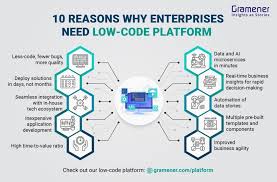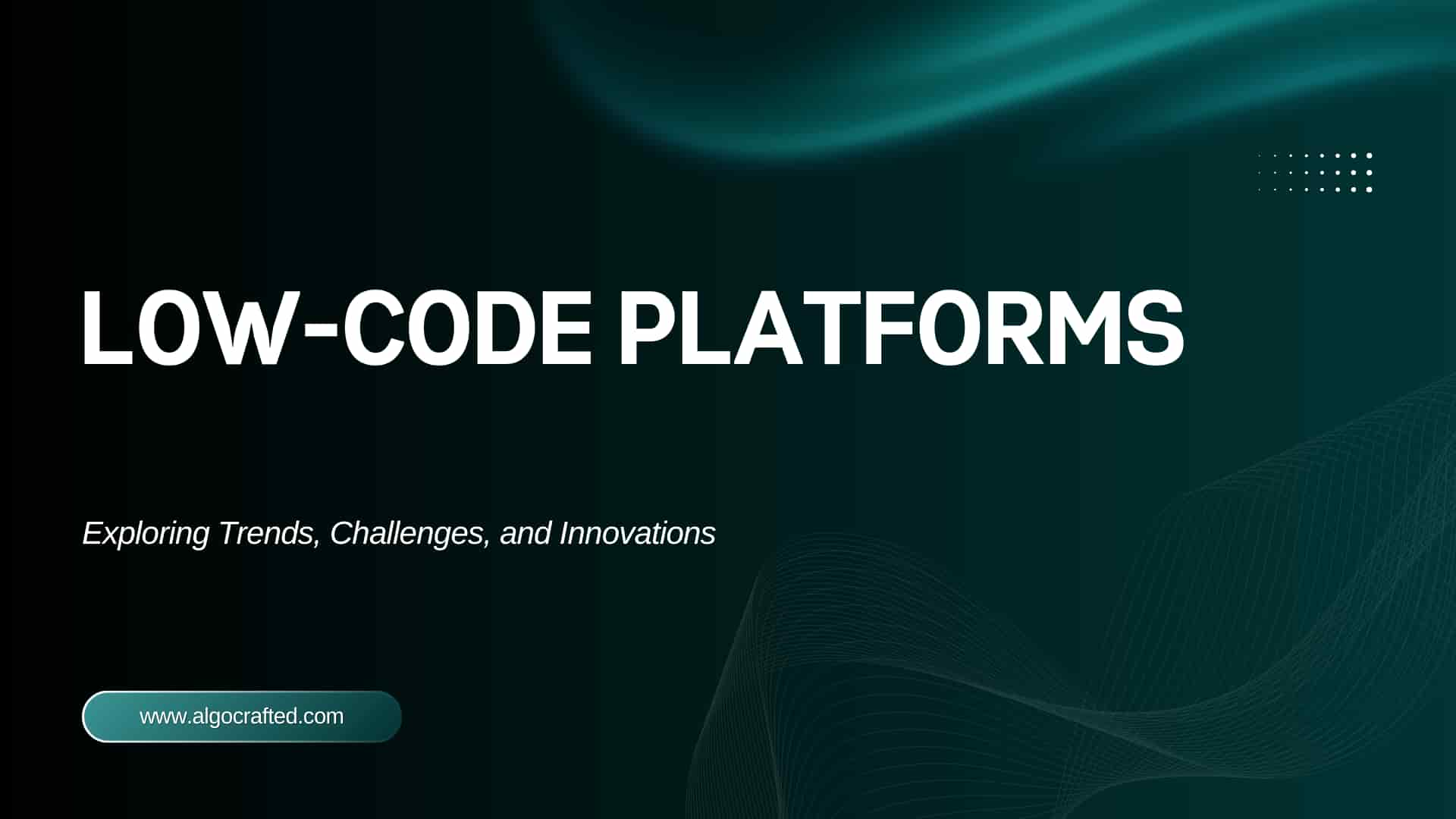Introduction: Why Low-Code Platforms Are a Beginner’s Dream
Ever had a brilliant idea for a fitness app to track your workouts or a marketing tool to supercharge your campaigns, only to realize coding is like deciphering alien script? You’re not alone! Gartner predicts that by 2025, 70% of new business apps will be built using low-code platforms—tools that let non-techies create powerful apps with minimal coding.
Whether you’re a digital marketing newbie dreaming of a custom campaign tracker or a health enthusiast designing a meal-planning tool, low-code development is your shortcut to success. Think of it as a magic wand that turns your ideas into reality without needing a PhD in computer science. In this guide, we’ll explore what low-code platforms are, why they’re perfect for beginners, and how you can start building today. Ready to become an app-building rockstar? Let’s dive in!
What Are Low-Code Development Platforms?
A low-code platform is a user-friendly tool that simplifies app development by minimizing the need for traditional coding. Instead of writing complex code, you use drag-and-drop interfaces, pre-built templates, and visual editors to create apps, websites, or workflows. It’s like assembling a Lego masterpiece—snap the pieces together, and you’re done! These platforms are ideal for beginners in digital marketing and health who want to create tools without wrestling with tech jargon.
How Do Low-Code Platforms Work?
Low-code platforms make app-building intuitive with:
-
Drag-and-Drop Editors: Arrange buttons, forms, and charts like puzzle pieces.
-
Pre-Built Templates: Start with ready-made designs for fitness apps, marketing dashboards, or e-commerce tools.
-
Automation Tools: Connect your app to external services, like syncing workout data with Fitbit or automating email campaigns.
-
Backend Support: Platforms handle databases, hosting, and security, so you focus on design, not tech headaches.
For example, a digital marketer could use Bubble to create a landing page with a sign-up form in hours, while a health enthusiast might use Zoho Creator to build a yoga app with guided sessions.
Read more: Top 8 Revolutionary AI-Powered Code Debugging Tools in 2025
Why Low-Code Platforms Are Perfect for Beginners
Low-code platforms are like training wheels for app development—accessible, fast, and forgiving. Here’s why they’re a game-changer for digital marketing newbies and health enthusiasts.
Save Time and Money
Traditional app development can take months and cost thousands. Forrester reports that low-code platforms cut development time by up to 80%. A digital marketer can launch a campaign tracking tool in days, while a health enthusiast can create a nutrition app without emptying their wallet.
No Coding Skills Needed
You don’t need to know Python, JavaScript, or any coding language. Platforms like Bubble, OutSystems, and AppGyver offer intuitive interfaces that feel like playing a creative game. It’s like cooking with a meal kit—everything’s prepped, and you just follow the steps.
Endless Customization
Want a marketing tool with real-time analytics or a fitness app with workout logs? Low-code platforms let you tweak designs to match your vision. You’re the artist, and the platform is your canvas.
Scalability for Growth
Start small with a basic app, then scale up as your needs grow. Many platforms support enterprise-level features, so your marketing dashboard or health app can evolve with your audience.

Top Low-Code Platforms for Beginners
Not sure where to start? Here’s a comparison of beginner-friendly low-code platforms to help you choose.
|
Platform |
Best For |
Key Features |
Cost |
|---|---|---|---|
|
Bubble |
Digital marketing tools |
Drag-and-drop editor, responsive design, integrations |
Free tier; paid plans from $29/month |
|
OutSystems |
Enterprise apps |
AI-assisted development, robust security |
Free trial; enterprise pricing |
|
AppGyver |
Mobile apps |
Visual builder, free for small projects |
Free; premium plans available |
|
Zoho Creator |
Health apps |
Workflow automation, wearable integration |
Starts at $8/user/month |
|
Adalo |
Mobile-first apps |
No-code mobile app builder, user-friendly |
Free tier; paid plans from $45/month |
How to Start Building with Low-Code Platforms
Ready to create your first app? Follow these steps to kick off your low-code journey.
-
Define Your Purpose: Decide what your app does. A marketing dashboard to track ad performance? A fitness tracker for daily workouts?
-
Pick a Platform: Choose a tool like Bubble for marketing or Zoho Creator for health apps based on your needs.
-
Explore Templates: Use pre-built templates to save time, like a marketing funnel or workout log.
-
Design Your App: Drag and drop elements like buttons, forms, or charts to build your interface.
-
Connect Data: Link your app to tools like Google Analytics for marketing or Fitbit for health stats.
-
Test and Launch: Preview your app, fix bugs, and share it with the world!
Example: Sarah, a digital marketing beginner, used Bubble to create a landing page for her freelance services. She added a sign-up form and connected it to Mailchimp for email automation—all in one weekend!
Read more: Enterprise Low-Code Application Platforms
Benefits of Low-Code for Digital Marketing and Health
Low-code platforms aren’t just easy—they’re transformative. Here’s how they empower beginners in specific fields.
Digital Marketing: Supercharge Campaigns
Marketers can create custom tools to track ROI, automate emails, or build landing pages. For instance, Bubble lets you design a dashboard to monitor ad performance across platforms like Google Ads and Facebook. This saves time and keeps you agile in competitive markets. Plus, you can A/B test landing pages without hiring a developer.
Health Enthusiasts: Build Wellness Tools
Health buffs can create apps for meal planning, workout tracking, or mindfulness. Zoho Creator offers templates for health apps that sync with wearables like Apple Watch. Imagine a custom app that reminds you to drink water or logs your yoga sessions—it’s like having a personal coach in your pocket.
Real-World Case Studies: Low-Code Success Stories
Seeing low-code in action can inspire you to start. Here are two beginner success stories.
Case Study 1: Marketing Maven’s Campaign Tracker
Lisa, a digital marketing freelancer, wanted a tool to track her clients’ social media campaigns. Using Bubble, she built a dashboard that pulled data from Instagram and Twitter, displaying engagement metrics in real-time. The app saved her 10 hours a week, and her clients loved the custom reports. Total cost? Just $29/month for Bubble’s paid plan.
Case Study 2: Fitness Guru’s Workout App
Mike, a fitness coach, used Zoho Creator to create a mobile app for his clients. The app included workout plans, progress trackers, and integration with Fitbit. His clients raved about the personalized experience, and Mike gained 50 new subscribers in three months. Best part? He built it in two weeks without coding.
Internal Link 4: [Link to “How to Monetize Your App”] with anchor text “monetize your app.”
Image 4 Placement: Place after “Real-World Case Studies”
Image 4 Description: A cheerful cartoon of two beginners (a marketer and a fitness coach) high-fiving in front of their low-code apps.
Image 4 Prompt: “Create a cheerful cartoon of a marketer and a fitness coach high-fiving in front of their low-code apps, with icons like graphs and dumbbells.”
Common Challenges and How to Overcome Them
Low-code is beginner-friendly, but it’s not flawless. Here’s how to tackle common hurdles.
Learning Curve
Platforms like OutSystems can feel complex at first. Solution: Start with free tutorials or community courses. Bubble’s academy, for example, offers step-by-step guides for beginners.
Limited Advanced Features
Free plans may restrict complex functionality. Solution: Opt for platforms like AppGyver for flexibility or upgrade to paid plans for more control.
Scalability Concerns
Basic apps may struggle with large user bases. Solution: Test performance early and choose enterprise-ready platforms like OutSystems for bigger projects.
Pro Tips to Master Low-Code Development
Want your low-code project to stand out? Try these expert tips:
-
Start Small: Build a simple app, like a to-do list, to learn the platform.
-
Leverage Communities: Join forums like Bubble’s community for templates and advice.
-
Test Across Devices: Ensure your app works on mobile and desktop.
-
Add Integrations: Connect to tools like Google Analytics for marketing or Strava for fitness.
-
Stay Updated: Follow platform blogs for new features and updates.
-
Backup Your Work: Save versions of your app to avoid losing progress.
Internal Link 5: [Link to “How to Use Google Analytics for Beginners”] with anchor text “Google Analytics guide.”
Image 5 Placement: Place after “Pro Tips to Master Low-Code Development”
Image 5 Description: A dynamic infographic listing “Top 5 Low-Code Tips” with icons for testing, integrations, and community support.
Image 5 Prompt: “Design a dynamic infographic listing ‘Top 5 Low-Code Tips’ with colorful icons for testing, integrations, community support, and more.”
Advanced Low-Code Features to Explore
As you grow, low-code platforms offer advanced tools to level up your apps:
-
AI Integration: Platforms like OutSystems use AI to suggest design improvements.
-
Custom Code: Add snippets of JavaScript for unique features, like interactive charts.
-
APIs: Connect your app to external services, like payment gateways for e-commerce.
-
Multi-User Support: Build apps for teams, like a shared marketing calendar.
Example: A health enthusiast could use Adalo to create a community fitness app where users share workout challenges, integrating with Strava’s API for real-time data.
Read more: 20 Best Low-Code Platforms for Building Applications in …
Conclusion: Your Low-Code Journey Starts Now!
Low-code platforms are a beginner’s superpower, turning app-building dreams into reality without coding nightmares. Whether you’re a digital marketer crafting a campaign tracker or a health enthusiast designing a wellness app, tools like Bubble, Zoho Creator, and AppGyver make it fast, fun, and affordable. With drag-and-drop interfaces, pre-built templates, and endless customization, you’re just a few clicks away from launching your first app. So, what’s stopping you? Pick a platform, start small, and watch your ideas come to life. Got a dream app in mind? Share your plans in the comments, or tell us which low-code platform you’re excited to try!

FAQs About Low-Code Platforms
1. What is a low-code platform?
A low-code platform lets you build apps with minimal coding, using drag-and-drop tools and templates. It’s perfect for beginners creating marketing or health apps fast.
2. Are low-code platforms free to use?
Many platforms, like AppGyver, offer free tiers, but advanced features require paid plans. Pricing starts at $8/month for tools like Zoho Creator.
3. Can I build mobile apps with low-code?
Yes! Platforms like Adalo and AppGyver specialize in mobile apps, offering responsive designs for fitness trackers or marketing tools.
4. Do low-code platforms need coding skills?
No coding is required for basic apps, but some platforms allow custom code for advanced features, giving you flexibility as you learn.
5. Which low-code platform is best for beginners?
Bubble and Zoho Creator are top picks for their user-friendly interfaces and templates tailored for marketing and health apps.


В этой информационной статье вы найдете интересное содержание, которое поможет вам расширить свои знания. Мы предлагаем увлекательный подход и уникальные взгляды на обсуждаемые темы, побуждая пользователей к активному мышлению и критическому анализу!
Углубиться в тему – https://vyvod-iz-zapoya-1.ru/